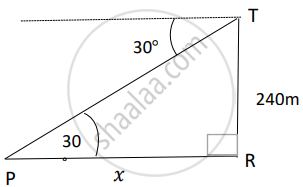Advertisements
Advertisements
Question
|
Case Study Trigonometry in the form of triangulation forms the basis of navigation, whether it is by land, sea or air. GPS a radio navigation system helps to locate our position on earth with the help of satellites. |
- Make a labelled figure on the basis of the given information and calculate the distance of the boat from the foot of the observation tower.
- After 10 minutes, the guard observed that the boat was approaching the tower and its distance from tower is reduced by 240(`sqrt(3)` - 1) m. He immediately raised the alarm. What was the new angle of depression of the boat from the top of the observation tower?
Solution
i.

In ∆PTR, tan 30° = `240/x` ⇒ x = `240sqrt(3)` m
ii. Distance of boat from tower = `240sqrt(3) - 240(sqrt(3) - 1)` = 240 m
Let the angle of depression = θ
tan θ = `240/240` = 1 ⇒ θ = 45°
APPEARS IN
RELATED QUESTIONS
If the point A(0, 2) is equidistant from the points B(3, p) and C(p, 5), find p. Also, find the length of AB.
An equilateral triangle has two vertices at the points (3, 4) and (−2, 3), find the coordinates of the third vertex.
Find value of x for which the distance between the points P(x,4) and Q(9,10) is 10 units.
Using the distance formula, show that the given points are collinear:
(-1, -1), (2, 3) and (8, 11)
Find the distance between the following pair of points.
L(5, –8), M(–7, –3)
Determine whether the points are collinear.
L(–2, 3), M(1, –3), N(5, 4)
Find the value of m if the distance between the points (m , -4) and (3 , 2) is 3`sqrt 5` units.
Prove that the points (4 , 6) , (- 1 , 5) , (- 2, 0) and (3 , 1) are the vertices of a rhombus.
Prove that the points (0 , 0) , (3 , 2) , (7 , 7) and (4 , 5) are the vertices of a parallelogram.
A point P lies on the x-axis and another point Q lies on the y-axis.
If the abscissa of point P is -12 and the ordinate of point Q is -16; calculate the length of line segment PQ.

